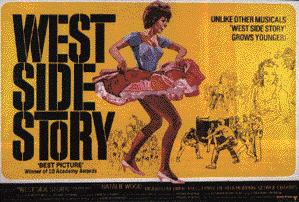
West Side Story (1961)

West Side Story begins with a remarkable opening shot from a helicopter in which the West Side of Manhattan (specifically the "Hell's Kitchen" area) is seen as a series of geometric patterns. It then zooms in to one particular area as if to say "We've chosen this section, but if we opted for another neighborhood, the story would have been different, but equally interesting." The credits by Saul Bass appear as graffiti scrawled on walls and set the tone immediately.
The viewer is then plunged into the tragic tale of two lovers from separate worlds. There is great racial tension between the established Anglo gang, the Jets, and the Puerto Ricans, known as the Sharks. They are all teenagers in conflict over "turf." The Sharks are lead by Bernardo (George Chakiris), whose tempestuous girlfriend is Anita (Rita Moreno). There is a sort of truce between the two gangs, and when Bernardo's sister, Maria (Natalie Wood), arrives from Puerto Rico, she is warned by Anita to stay away from the Anglos. Maria doesn't heed the warning. Star-crossed lovers Maria meets Tony (Richard Beymer), a Polish boy who is one of the Jets. The young lovers fall hard for each other, thus incurring the wrath of both gangs (who represent the warring Montagues and Capulets of Shakespeare's tragedy). There are warnings and threats, and the result is a final showdown between the gangs.
Maria tries to stop the impending battle by persuading Tony into a show of peace but fails, and the leader of the Jets, Riff (Russ Tamblyn), dies in a knife fight with Bernardo. Tony has been calm and cool to this point, but at seeing his pal stabbed, he grabs a knife and stabs Bernardo to death. Now he races to Maria's side and pleads with her to understand why he did what he did and how there was no way out. He also asks that she go away with him to a better place. They are about to leave when Tony is tracked down by the surviving members of the Sharks, trapped in a playground, then killed by the gang. Maria kneels beside Tony and cries bitterly while members of both gangs watch, and the trio of deaths starts to register on them. In the end, the gangs join forces to haul the dead Tony out of the playground, and there is a faint glimmer of hope that the carnage may have ceased with his demise.
West Side Story has become one of the most popular film musicals in history. It's a combination of fantasy and reality and doesn't always work. The sets were obvious sets, and the streets were obvious streets, thus jarring the senses somewhat. They might have done better had they remained with one style rather than attempting to blend them. Film's assets The greatest asset to the play and the film was the dancing by Robbins. It's a combination of ballet, acrobatics, and jazz, and even though the picture of tough gang members doing obvious steps brought laughter to streetwise youngsters in New York, that didn't seem to matter to the rest of the country, which had no idea what gang life was like in reality. On the stage, Harold Prince and Robert Griffith were able to convey with their production a sense of power without having to expand the confines of the Winter Garden. Robbins used the palette of the screen to create even more spectacular dance numbers than had been seen on stage, and the result is exciting showmanship in every scene he personally oversaw.
On a radio interview, lyricist Stephen Sondheim was quoted years later as saying that, although the play received wonderful notices from the New York critics, the score did not. Hardly anyone mentioned his lyrics or Leonard Bernstein's music; all they raved about was the staging and dancing. It wasn't until this movie was about to be released and the power of a large studio got behind it that the tunes began to be plugged on the radio, and the result was several hits. Since Wood was not a singer or a dancer, some creativity had to be exercised to make it appear that she was. Using someone else's voice as the singer is easy enough but faking the dancing required some careful planning. She was handed some easy steps to do, but through excellent camera planning it appeared that she was doing more than she actually was.
Music Sondheim and Bernstein's songs were: "Prologue" (the Jets and the Sharks), "Jet Song" (Tamblyn, the Jets), "Something's Coming" (Beymer), "Dance at the Gym" (Wood, Beymer, Jets, Sharks), "Maria" (Beymer), "America" (Moreno, Chakiris, Sharks, and Female Sharks), "Tonight" (Wood, Beymer), "One Hand, One Heart" (Wood, Beymer), "Gee, Officer Krupke" (Tamblyn, Jets), "Quintet" (Beymer, Wood, Moreno, Sharks, Jets), "Rumble" (Jets, Sharks), "Cool" (Tucker Smith, Jets), "I Feel Pretty" (Wood, Suzie Kaye, Yvonne Othon, Joanne Miya), "Somewhere" (Beymer, Wood), "A Boy Like That," and "I Have a Heart" (Wood, Moreno). Although Wood and Beymer are listed as singing the songs, neither of their voices were on the sound track. Wood's "voice" was actually done by veteran Marni Nixon, and Beymer's voice was substituted by Jimmy Bryant.
CAST:
PERFORMER, CHARACTER
Natalie Wood, Maria
Richard Beymer, Tony
Russ Tamblyn, Riff
Rita Moreno, Anita
George Chakiris, Bernardo
Tucker Smith, Ice
Tony Mordente, Action
PRODUCTION:
Producer, Robert Wise
Directors, Robert Wise and Jerome Robbins
Screenwriter Ernest Lehman, based on the stage play by Arthur Laurents, based on a conception by Robbins, inspired by a play by William Shakespeare
Editor, Thomas Stanford
Cinematographer, Daniel Fapp
Music Directors, Johnny Green and Saul Chaplin
Composer, Leonard Bernstein
Lyrics, Stephen Sondheim
Choreography, Jerome Robbins